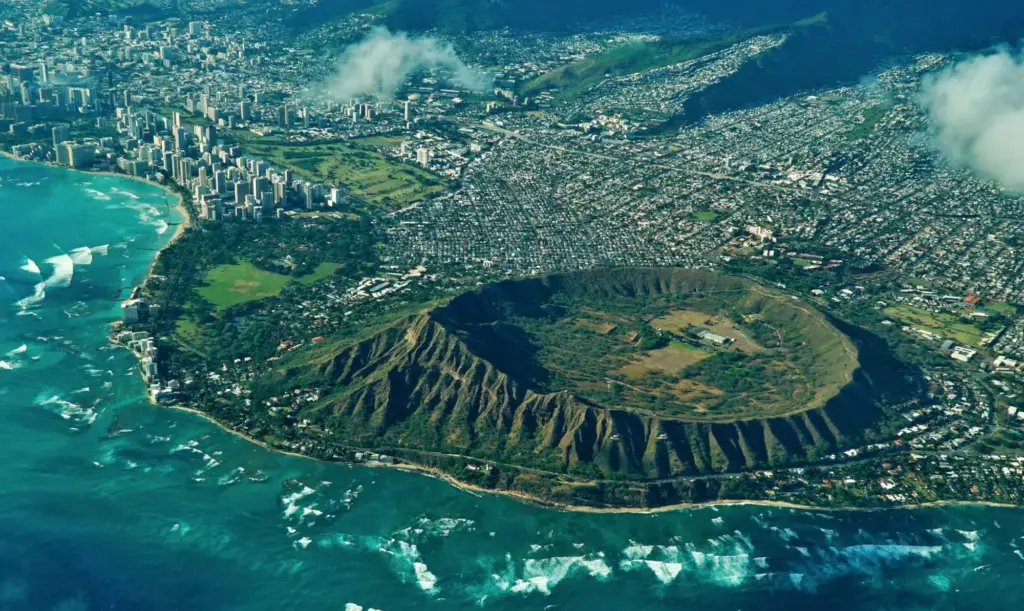Diamond Head, known in Hawaiian as Lē‘ahi, is one of the most iconic natural landmarks in Hawaii. This 500,000-year-old volcanic tuff cone is located on the island of O‘ahu, near the vibrant city of Honolulu. Its unique geological features, rich cultural history, and panoramic views make it a must-visit destination for tourists and locals alike.

Formation and Geology
Origins of a Tuff Cone
Diamond Head was formed approximately 500,000 years ago during a single, explosive volcanic eruption. The eruption created a large crater as magma interacted with groundwater, producing a violent blast of steam and ash. This ash settled and solidified into a tuff cone, a type of volcanic formation composed of consolidated volcanic ash and debris.
Unlike typical volcanoes with multiple eruptions, Diamond Head is considered a monogenetic volcanic cone, meaning it erupted only once. Its dormant state has lasted for hundreds of thousands of years, and there is no indication it will erupt again.
Physical Characteristics
- Height and Size:
The summit of Diamond Head rises about 232 meters (760 feet) above sea level, while the diameter of the crater spans approximately 1 kilometer (0.6 miles). - Geological Layers:
The walls of the crater showcase layers of compacted ash, giving visitors a glimpse into its volcanic past. Erosion over the centuries has sculpted its rugged appearance, contributing to its distinct shape.

Name and Cultural Significance
Hawaiian Name: Lē‘ahi
The Hawaiian name Lē‘ahi translates to “brow of the tuna,” referencing the crater’s resemblance to the dorsal fin of a tuna fish. According to Hawaiian legend, the goddess Pele and her sister Hi‘iaka named the site after its distinctive shape.
Western Name: Diamond Head
The name “Diamond Head” was given by 19th-century British sailors who mistook the sparkling calcite crystals embedded in the tuff rocks for diamonds. While the “diamonds” turned out to be worthless minerals, the name stuck, and Diamond Head became an enduring symbol of Hawaii.
Strategic and Historical Importance
Military Significance
Due to its elevated position and strategic location overlooking the Pacific Ocean, Diamond Head has played a critical role in Hawaii’s defense history.
- Fort Ruger:
In the early 20th century, the U.S. military built Fort Ruger within the Diamond Head crater to serve as a coastal defense base. The fort included bunkers, tunnels, and observation posts, some of which are still visible today. - World War II:
During World War II, Diamond Head served as a key lookout point for monitoring naval activities in the Pacific. The remnants of military structures, such as the Fire Control Station, are popular stops along the hiking trail.
Recreational Opportunities
Hiking Diamond Head
The Diamond Head Summit Trail is one of O‘ahu’s most famous hiking routes. Originally constructed in 1908 as part of military fortifications, the trail offers an exhilarating journey through history and nature.
- Trail Length:
The hike is 1.3 kilometers (0.8 miles) one way and takes about 1 to 2 hours round trip. - Trail Features:
The path includes steep switchbacks, staircases, and dark tunnels, culminating in a spectacular panoramic view of Honolulu, Waikīkī Beach, and the vast Pacific Ocean.
Scenic Views
From the summit, visitors are rewarded with breathtaking vistas of the island’s southern coastline, turquoise waters, and lush green landscapes. This vantage point has made Diamond Head a favorite spot for photographers and nature enthusiasts.

Ecological Importance
Diamond Head is home to unique flora and fauna adapted to its dry, rugged environment. Native Hawaiian plants, such as ‘ilima and naio, thrive within the crater. Bird species like the zebra dove and common myna can also be spotted. Conservation efforts aim to preserve the delicate ecosystem and prevent the spread of invasive species.
Like Us on Facebook!
Diamond Head Today
State Monument
Designated as a U.S. National Natural Landmark in 1968, Diamond Head is now a protected area managed by the State of Hawaii. The Diamond Head State Monument attracts over a million visitors annually, offering a blend of natural beauty, history, and outdoor adventure.
Subscribe Us on YouTube!
Accessibility
The monument is easily accessible from Honolulu, making it a convenient destination for tourists staying in Waikīkī. Facilities include parking, restrooms, and a visitor center with educational exhibits about the site’s history and geology.
Fun Facts
- Movie Star:
Diamond Head has appeared in numerous films and TV shows, including Blue Hawaii starring Elvis Presley. - Unique Shape:
From the air, Diamond Head’s crater resembles a near-perfect circle, a feature that is especially striking in aerial views. - Cultural Inspiration:
The crater has inspired countless artists, poets, and musicians, making it a cultural icon as much as a natural wonder.
Conclusion
Diamond Head stands as a remarkable blend of natural history, cultural heritage, and recreational appeal. Its unique geological features and breathtaking views make it a must-see destination for anyone visiting Hawaii. Whether you’re drawn by its volcanic origins, its military history, or the allure of its stunning vistas, Diamond Head promises an unforgettable experience.




















